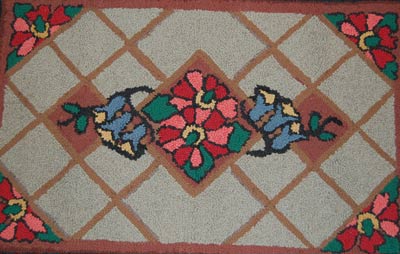Speaking of Antiquing – July 2014
Rug Hooking began in America in the New England states as a craft of poverty, a “country craft,” done out of sheer necessity and done in isolation. While wealthy homes had woven carpets from woolen mills, poorer families were using every available scrap of fiber and hooking them into loosely-woven fabric such as burlap. Burlap was available for free as it was reused from feed sacks. Flour sacks were also used, but made better backing for quilts so the looser weave fabrics were preferred for hooking.
Hooks were contrived to pull the thinly-cut strips of wool through, making small loops. Hooks could be as simple as a bent nail hammered into a piece of wood, (a makeshift handle) or tools that a blacksmith could forge. These handles worked quite well—in the same manner a crochet hook was used.
Wool was the fabric of choice as it was strong and long-lasting and readily available from discarded military uniforms. Flannel and worn cotton was also used but had a shorter wear and was, therefore, less desirable. Natural dyes from food and plants such as berries, walnuts, and onion skins were employed to give color to the design.
The earliest rugs considered to be “Primitive,” have few colors (no more than two or three) with a dark background. Designs were simple, almost childlike, as they were mostly hand-drawn, depicting family life such as children playing, cherished pets, flower gardens, farms, ships and patriotic themes. Geometric designs offered a myriad of designs as quilt patterns and simple configurations were also used.
In time, art superseded necessity and floor rugs found their way to adorning country homes in the way of table runners, pillows, foot stools and were proudly displayed on a hearth or wall as a prized work of art.
Hooked rugs are now considered to be a Folk Art and are highly valued by collectors. American Hooked Rugs dated 100 to 200 years-old representing a true “primitive” theme are the most sought-after.
Nowadays, there are many Hooked Rug Clubs (Hookers), that meet regularly to work on rugs and share designs and patterns. Today’s choices in designs range from the Hookers own self-drawn “primitive” pattern, to commercially-sold patterns printed on a backing with colors indicated as in paint-by-number art work.
Your valued Hooked Rug should never be vacuumed or washed in a washing machine. Gently shake it and never use a rug beater and use a damp cloth to dab when necessary. To store it, roll it inside/out and wrap in a cotton sheet and be sure to protect it from direct sunlight to avoid fading.
Come to Pickety Place Antiques here in Jacksonville and see the many early Hooked Rugs made in the 1920’s. They run the gamut of sizes and colors and portray the desirable whimsy that collectors seek today.

 Margaret Barns is co-owner of Pickety Place Antiques & Collectibles located at 130 N. 4th Street in Jacksonville. LIKE them on
Margaret Barns is co-owner of Pickety Place Antiques & Collectibles located at 130 N. 4th Street in Jacksonville. LIKE them on